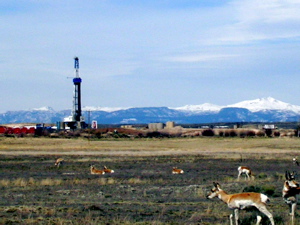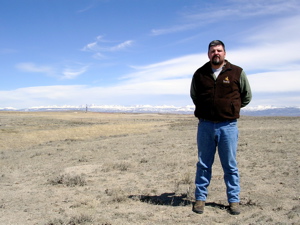
Guest Essay: Rollin Sparrowe
As Deer Decline, Energy Development Comes Under Fire
By Contributing Writer, 3-27-07


Caption: For a few years now, biologists, conservationists
and hunters warned about the escalating impacts of natural
gas drilling on big game herds near Pinedale, Wyoming. Now
studies confirm their worst fears. Inaction from the Bureau of
Land Management has angered hook and bullet groups and
caused people like Rollin Sparrowe to speak up. He testfied this
week on Capitol Hill that the BLM has shirked its duties to
protect wildlife in favor or processing as many drilling permits as
it can. Photo by Todd Wilkinson.

Throughout his distinguished career as a scientist with the U.S. Fish and Wildlife Service and as an influential coordinator of wildlife management programs with state game agencies, no one ever accused Dr. Rollin D. "Rollie" Sparrowe of carrying forward an agenda for environmentalists.
As a hunter and angler, Sparrowe promoted responsible stewardship and he carried that ethic with him when he and his wife retired to Wyoming along the western slope of the Wind River Mountains. Little did Sparrowe know but his backyard Shangri-la would soon become inundated by proposals for thousands upon thousands of natural gas wells that displaced wildlife and impaired their seasonal migration.
Shortly after the turn of this century began, with energy development rapidly escalating in the Jonah Field and the Pinedale Anticline—areas that have been compared to Africa's Serengeti because of their wildlife abundance—Sparrowe decided to work constructively as an involved citizen. Volunteering to serve on a working group assesing the impacts of drilling, he believed that the federal agency which backed its creation, the Bureau of Land Management, would listen. But it didn't.
Sparrowe now says he was wrong to not raise red flags earlier and this week he went to Washington, D.C. to testify about what he believes are serious violations of BLM stewardship duties on behalf of American citizens. He told lawmakers on Capitol Hill: “Proof that fish and wildlife are receiving little protection lies in past and future actions by the Bureau of Land Management. Pressures to accelerate approval of applications for permits to drill and otherwise facilitate development have led to virtual abandonment of other land management responsibilities for wildlife on many BLM trust lands. BLM resource managers have been reprogrammed to assist in processing permits as their first, and, in some instances, their only priority. Funding and staffing have been shifted away from the multiple-use mandate we expect from the agency under its authorizing legislation.”
Sparrowe, a technical wildlife expert who was a founding board member of the Theodore Roosevelt Conservation Partnership, a growing coalition of hunting and angling groups, wrote the following essay this winter about what is happening with drilling near Pinedale, Wyoming, amid a sweep of landscape that includes the Wind River and Wyoming Mountains; the Upper Green River Basin, which forms the headwaters to the Colorado River; and in spur ranges that used to be famous for their hunting. —Todd Wilkinson
BY ROLLIN D. SPARROWE
The recent release of research findings from the fifth year of vital studies of mule deer use of the Mesa on the Pinedale Anticline has again produced a customary "spin-doctoring" that has characterized the debate over Wyoming's wildlife affected by energy development.
Headlines like "Mesa Herd Stabilizes" published in local newspapers do a disservice to both deer and the interests of Wyoming deer hunters.
The facts, however, are that: 1. There are fewer than half the deer using the Mesa in winter than there were five years ago; 2. There is no evidence that any meaningful numbers of those deer have "just gone elsewhere" (as was suggested in 2005 by the federal Bureau of Land Management which is supposed to have oversight that protects the herd); and 3. New data show that only two percent may have emigrated from the Mesa, but that 27 percent of the total reduction in use can be attributed to energy development activities.
These findings confirm that while many other factors affect deer, energy development activity is an important contributor to the reduction in use of the Mesa by deer.
But let's get even more to the point.
We just experienced a tough deer season in Western Wyoming. Northern Wyoming Range and Hoback Basin deer hunters had trouble finding any deer, let alone good bucks. The common question at check stations and in the mountains was: "Where are the deer?"
Movement data on deer that winter on the Mesa show that many of them moved into the Northern Wyoming Range and Hoback Basin. Since there were much fewer deer in that segment of the Sublette Deer Herd on the Mesa in winter, should it surprise us that the quality of deer hunting in those connected areas has declined sharply?
The "stabilization" claim is based on the fact that deer on the Mesa have numbered about 2,800 for two years, and didn't decline further—yet. But remember, five years ago there were almost 6,000—should we therefore be happy with half a herd?
Of greater significance is that new data show reduced reproductive success in the Mesa herd versus neighboring herds. This adds up to bad news for the future of this deer herd, those who love to hunt deer in the Wyoming Range and Hoback Basin, and those communities that rely on the economic benefits from hunting.


As a wildlife biologist with the federal Bureau of Land
Management assigned to the agency's Pinedale office,
Steve Belinda tried continuously to call his superiors'
attention to impacts on mule deer, ponghorn, sage grouse
and other species caused by an expanding footprint of
gas drilling. But he says his concerns were constantly
ignored and he was marginalized. Finally, he resigned in
disgust and went to work as a staff expert with the Theodore
Roosevelt Conservation Partnership. Belinda is also a committed
sportsman. This photo was taken in spring 2005 on the Pinedale
Anticline while Mr. Belinda was still employed by BLM. Today,
thousands of new gas wells are proposed for the Mesa area of
the Anticline mentioned in Sparrowe's essay. The Wind River
Mountains loom in the distance. Photo by Todd Wilkinson.

A MATTER OF HARSH SURVIVAL
Drought, predators, houses, roads, and other factors that influence these deer have been a part of the mule deer world for a long time, but during previous drought and periodic severe winters, Mesa deer have been able to use the Mesa and adjacent habitat to cope with winter snows, wind and extreme cold. Now they cannot do that.
What is new and NOT natural is the high level of human disturbance and change int he landscape brought on by energy development.
The real issue is not arguing over which influence is worse than the other, but given the likelihood of periodic harsh Wyoming winters, can these deer still survive and recover?
We may well get an answer soon. The Wyoming Game and Fish Department warned us this year that even with moderate winter, current poor forage conditions make a die-off likely, so protections from winter disturbance are extremely important. Mule deer are now at a crossroads where they are clearly in trouble under heavy development pressure.
It seems clear that some part of energy development has to be scale back or deer and deer hunters will lose even more than they already have. And yet, the signs are not good—leasing to drill on migration and summer ranges threats the REST of the annual deer habitat.
Recently, the BLM had to withdraw proposals for leases near Merna because they had NOT evaluated their importance to Mesa deer. There has been an uprising of hunters and outfitters opposing further development in the Wyoming Range.
When petititioned last spring by the citizen-based Pinedale Anticline Working Group (whose formation was promoted by the BLM as a form of outreach to citizens and user groups) to adopt goals of no further reduction in this herd, BLM REFUSED.
All that was proposed by BLM was to get the BLM, Wyoming Game and Fish Department, industry and other interested publics together to consider what might be done differently to ease the pressure on this herd.
BLM promised to "work with the Game and Fish Department to find ways to assist the herd." This winter, the BLM released a draft Supplemental Environmental Impact Statement for the Pinedale Anticline based on a proposal from industry that will include a major increase in activity on parts of the Mesa in winter.
This is apparently in trade for less activity elsewhere. Hunters and others must examine this proposal carefully. Is more winter drilling the best we can expect from the key federal management agency?
NOT AN ISOLATED INCIDENT
This bad scenario for mule deer is being re-enacted elsewhere, such as the Atlantic Rim in southcentral Wyoming, Piceance Basin and Roan Plateau in Colorado, and Book Cliffs in Utah and Colorado.
No one has the ability to evalucate the effects on mule deer of tens of thousands of well sites in the Powder River Basin of Montana and Wyoming. This fast pace of development is cutting at the very heart of some of the most valued mule deer locations in the Northern Rockies and none of our agencies are fully taking care of our interests.
Residents and nonresident hunter dollars are the biggest support base for Wyoming wildlife programs.
It is time to quit being satisfied with "half a deer herd."
Hunters should demand nothing less than action from government and industry to arrest the decline of the "stabilized" Mesa Herd and assure that the same decline does not happen in other key mule deer herds.
Partners in the Theodore Roosevelt Conservation Partnership have devleoped a set of principles to assist wildlife through the onslaught of energy development. They may be viewed at http://www.trcp.org
We welcome partnership with hunters, anglers, organizations, businesses and everyone else who cares about the future of mule deer and other wildlife affected by energy development. We say it is not being "done right"—mule deer are a prime example and half a mule deer herd is not acceptable.





